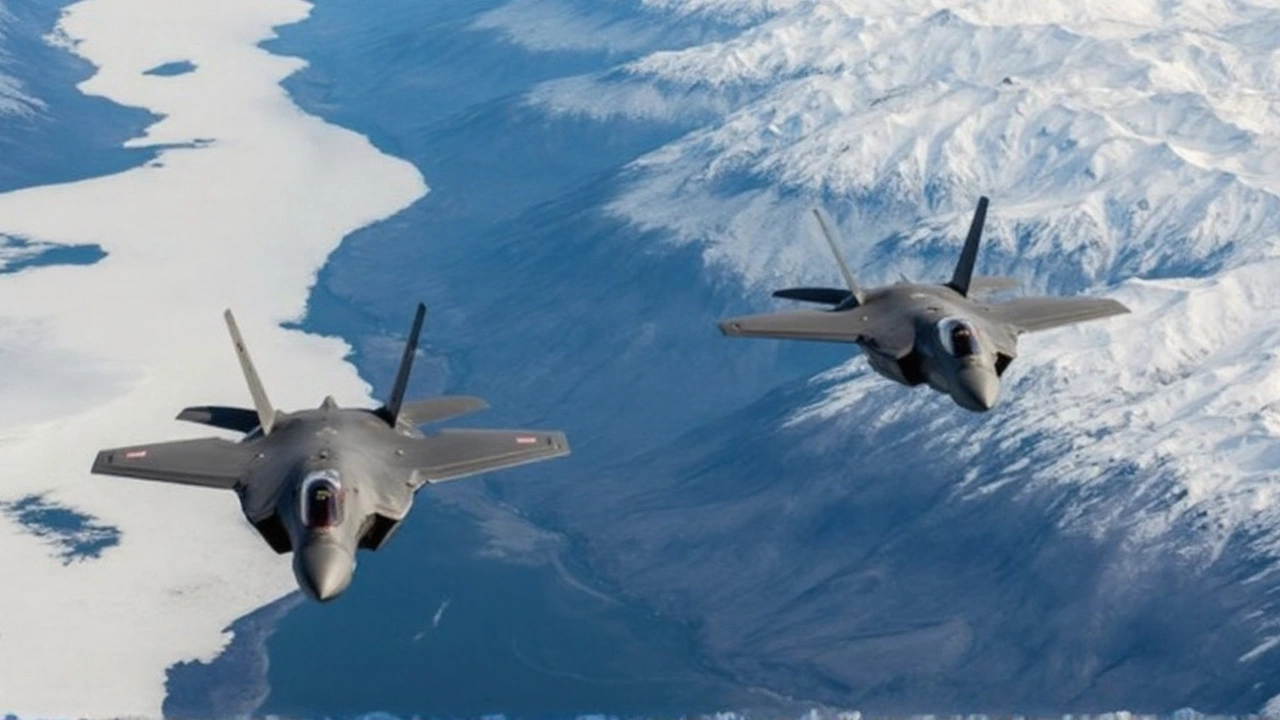F-35 crash in Alaska: ice fooled jet’s sensors and flipped it into ground mode
Ice turned a cutting-edge jet into dead weight
A $196.5 million fighter jet went down in Alaska because ice inside its landing gear tricked the aircraft into thinking it was rolling on a runway while it was still flying. That’s the core finding from an Air Force Aircraft Accident Investigation Board report on the January 28, 2025 F-35 crash at Eielson Air Force Base.
The F-35A from the 355th Fighter Squadron was on a routine air-to-air training mission when its landing gear system began to fail. Video from the range showed the stealth jet pitch up, tumble into a near-vertical drop, and explode on impact. The pilot ejected, survived with minor injuries, and walked to the ambulance. The aircraft was destroyed.
Investigators say the chain reaction started on the ground. Hydraulic fluid in the jet’s landing gear was contaminated with water. In subzero temperatures—about 0°F at taxi—the water froze inside the nose and main gear struts. That ice set off a cascade of failures: the nose gear wouldn’t retract cleanly after takeoff, later attempts to re-extend the gear left the nose wheel misaligned, and ice kept building. As ice clogged the main gear struts, a set of “weight on wheels” sensors began to report the jet was on the ground. Those sensors are hard-wired into the F-35’s flight control logic. Fed bad data, the jet slipped into a ground-control mode that made it uncontrollable in the air.
The pilot—an experienced aviator with roughly 1,700 hours in the A-10 and 555 hours in the F-35—exhausted checklists and spoke with engineers through the supervisor of flying. The team held the jet airborne for about 50 minutes trying to center the nose gear and stabilize the situation. When the control laws flipped fully into ground mode aloft, the aircraft stopped responding as a flyable airplane. The pilot punched out.
The board traced the root cause to maintenance mistakes: the 355th Fighter Generation Squadron didn’t follow rules for storing and handling hydraulic fluid barrels. The jet was serviced from a barrel that had significant water contamination, according to the report. In a harsh Arctic climate, that’s a recipe for ice.

How a few ounces of water brought down a fifth-gen fighter
It sounds absurd—ice in the landing gear sinking one of the world’s most advanced fighters. But the path from water to wreckage is straightforward once you break it down.
First, the timeline matters. On January 28, temperatures hovered around 0°F. After engine start, the F-35 waited on the ground for roughly 40 minutes while other jets in the formation worked through minor issues. That long hold gave any moisture in the hydraulic lines and struts time to cool and freeze.
- 10:42 a.m. local: The jet taxied from its shelter in near-zero temperatures.
- ~40 minutes: Ground hold as the rest of the formation troubleshot.
- 11:22 a.m.: Takeoff. The nose landing gear didn’t retract cleanly.
- Post-takeoff: Attempts to cycle and extend the gear left the nose wheel canted about 17 degrees left, preventing a proper lock.
- ~50 minutes airborne: The pilot ran emergency checklists and coordinated with engineers while holding.
- Late in the sequence: Ice buildup in the main gear led weight-on-wheels sensors to think the jet was on the ground. Flight controls switched to ground law. The aircraft became unflyable. The pilot ejected; responders reached the crash site within one minute.
Landing gear struts rely on hydraulic fluid to move, damp, and lock. If water is mixed into that fluid, freezing temperatures can plug passages and lock valves. On the F-35 that’s not just a mechanical headache. The jet’s safety systems depend on whether the aircraft is airborne or “on wheels.” When sensors say “on wheels,” the jet shifts to a ground-control logic that supports taxi, steering, and braking—not flight. If those sensors read ground while the jet is aloft, the computers can limit or change control authority in ways that no pilot can safely fight through.
Investigators say all valid weight-on-wheels channels falsely indicated a ground condition. That’s unusual; systems like this often cross-check multiple inputs to avoid a single-sensor failure. But ice doesn’t fail one thing neatly. It altered how the landing gear sat, changed alignment, and blocked strut movement. The result: an internally coherent but incorrect picture that fooled the logic.
The pilot did everything by the book. He worked the checklists, flew a safe hold, and used the base’s supervisor of flying to bring in Lockheed Martin engineers. The plan was to get the gear centered, confirmed, and ready for a controlled landing. As the cold soaked deeper into the hardware, any hope of that faded.
So how did the water get there? The board pointed to basic handling errors with hydraulic fluid barrels—things like improper sealing, storage, or exposure that lets condensation form. Even a small amount of water can spread through a system. In Arctic conditions, it becomes ice. And once ice nests in narrow hydraulic passages, the system can do unpredictable things despite clean cockpit indications.
This accident is a classic “normal day” trap: a minor contamination that doesn’t matter in the warm, a long ground wait that seems routine, a fix-in-the-air plan that mostly works—until a hard limit is crossed by the environment. The lesson isn’t new; Arctic operators have chased moisture for generations. What’s new is how deeply software and sensor logic tie into the basic ability to fly an aircraft like the F-35.
Eielson AFB is built for cold-weather ops, and its units train for these conditions all winter. Still, a jet that starts warm, idles long, then takes off into frigid air can see fast, uneven cooling. Metal shrinks. Fluids gel. Ice grows in tight corners. If maintenance has introduced moisture into the system, the cold finishes the job.
The report also highlights a subtle twist. Early on, the jet’s nose gear was the visible problem. But the fatal blow came later when ice inside the main gear struts drove the weight-on-wheels logic the wrong way. That means the aircraft’s sensors weren’t just fooled by a single jammed part; they were fooled by an entire landing gear state that looked ground-like to the software.
From a pilot’s seat, this is terrifying. You can feel, see, and know you’re flying, yet the aircraft starts behaving as if it’s taxiing. Flight control laws are designed to be conservative on the ground. In the air, those limits make the jet nearly unmanageable.
After the ejection, fire crews got to the crash site in under a minute. The pilot’s injuries were tied to the ejection sequence, not the crash itself. That is a credit to seat and survival systems that have had their own scrutiny in recent years across multiple fleets.
Beyond the mechanics, the organizational miss matters. Hydraulic fluids are supposed to be tightly controlled. Barrels should be sealed, stored correctly, and sampled. Units train for this. The board’s finding—improper handling by the fighter generation squadron—points to a lapse in discipline, not a missing rule. Expect a flurry of fixes: re-training, new sampling steps at the point of use, tighter storage protocols, and more aggressive moisture tests in the cold.
Here’s what to watch for next from the Air Force and the F-35 enterprise:
- Moisture control blitz: expanded sampling of hydraulic systems across local fleets, especially in subzero bases.
- Barrel and cart audits: checking seals, storage temperatures, and handling logs.
- Procedural changes for long ground holds in extreme cold, including time limits or mandatory returns to shelter.
- Software review: whether control law logic can add more cross-checks before shifting to ground mode aloft.
- Cold-weather advisories to partner fleets that operate F-35s in Norway, Finland, Canada, and other frigid regions.
The Alaska crash is one of roughly a dozen serious F-35 mishaps since 2018. The program’s critics will see more proof of a jet with too many moving parts. Supporters will point out that a fleet of thousands of sorties per year will have accidents, and that the overall incident rate remains comparatively low for a fifth-generation fighter spread across 19 countries. Both things can be true: the jet is complex and expensive, and it’s flown constantly by the U.S. and its allies. No one is parking it.
It’s also true that the last mile of reliability is often found in the basics. Water and cold beat an F-35 because of human handling errors on the ground. The fix starts there. Better barrel discipline. Better sampling. More conservative procedures when a formation hiccups and a flight sits idling in Arctic air.
There’s a software angle too. Modern fighters lean hard on automation. The F-35’s systems interpret the world and shape what the pilot can do. That protects crews most of the time. But when sensors are wrong in a consistent way, automation becomes a trap. Engineers will look at how to prevent a full shift into ground mode without rock-solid proof the jet is actually on wheels. Expect debates about overrides and safeguards that don’t open the door to new risks.
For the pilot, the ordeal was short and merciless at the end. He had the right experience, the right habits, and the right help on the radio. Once the control laws flipped, physics and code did the rest. That outcome will weigh on training communities that already drill sensor failures, iced systems, and partial gear emergencies. The question is what more can be done before takeoff to avoid getting boxed in at altitude.
Cold-weather flying has shaped military aviation for a century. Crews have learned to preheat systems, keep jets in shelters, cap idle times, and test sensors and hydraulics aggressively. The Alaska crash adds a specific reminder for F-35 units: moisture in landing gear systems is not a nuisance—it's a flight risk. In this case, it brought down a jet with stealth, fused sensors, and some of the best software ever loaded into a fighter.
The cost is painful. The jet is gone. Training was disrupted. Investigators logged months of work. The good news is the single injury was minor. But the real cost is confidence. Squadrons will spend time and energy hunting water and re-earning trust in the cold-weather playbook—work worth doing as winter training ramps up again at Eielson and across the Arctic basin.
This accident doesn’t change the F-35’s role. It remains the backbone of U.S. and allied airpower. It will keep flying from Alaska to the North Sea and the Pacific. What changes are the guardrails: more obsessive moisture control, shorter ground waits in the cold, and sharper rules for when to come back to the barn instead of pressing on. That’s how you keep a high-tech fighter from being undone by a basic freeze.





